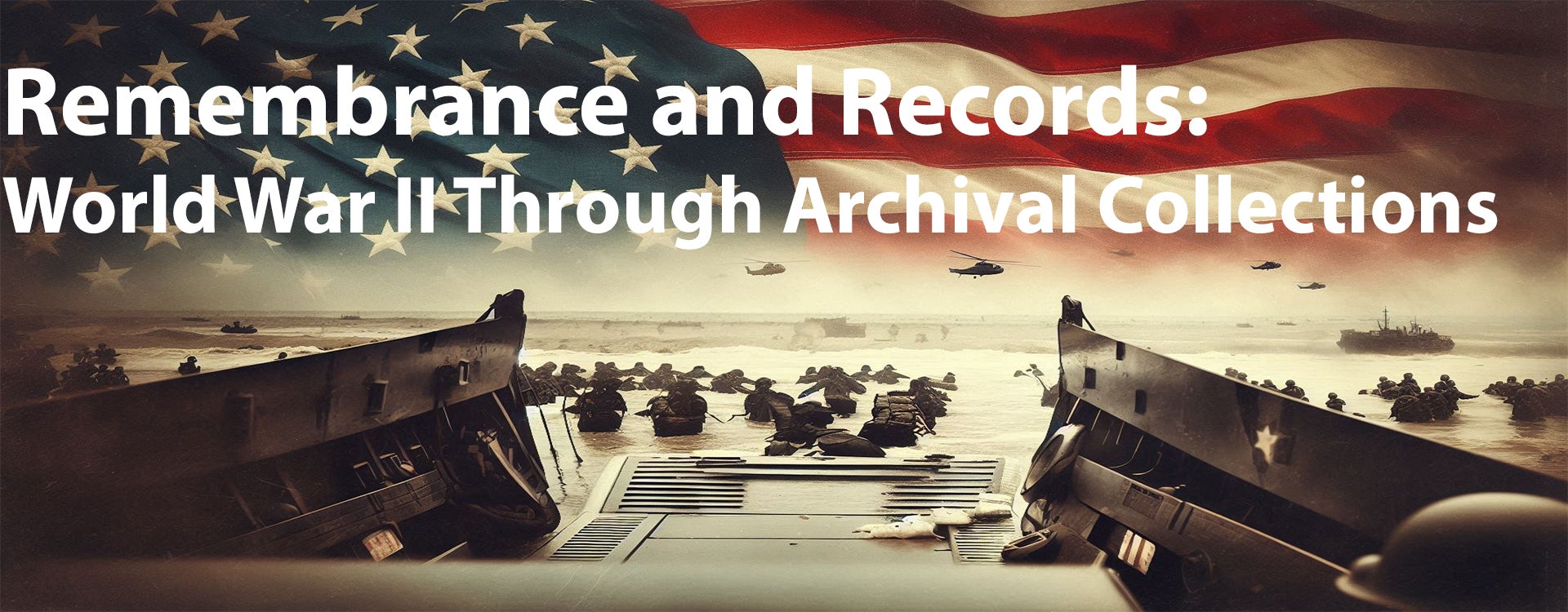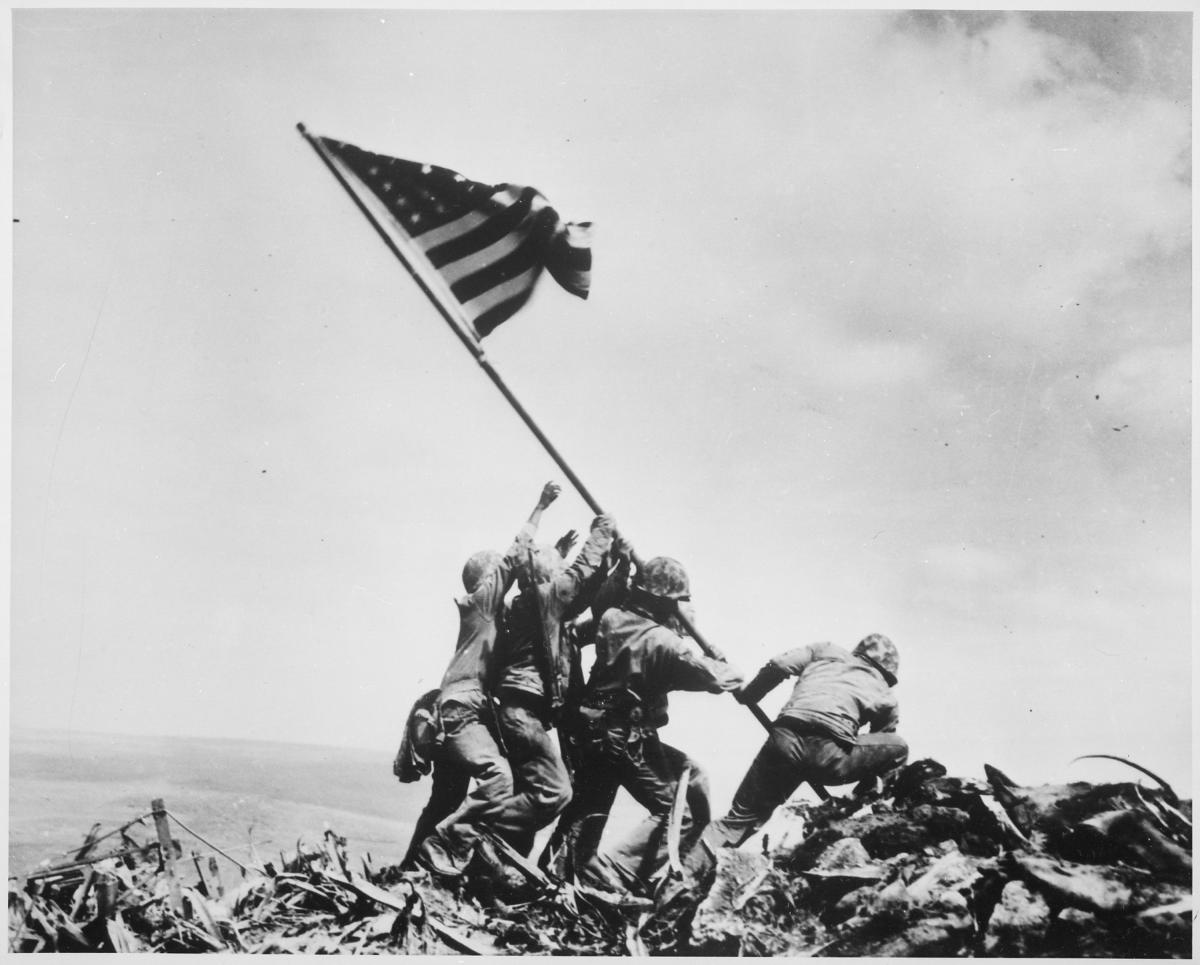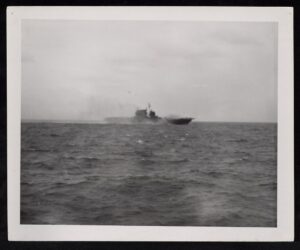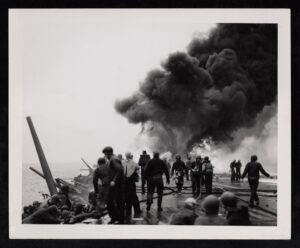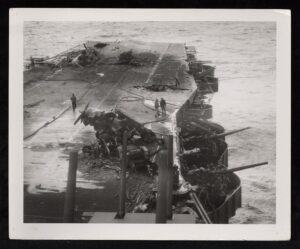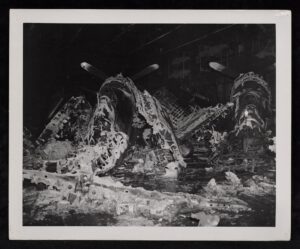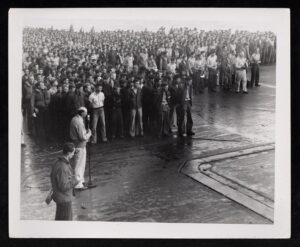Raising the Flag, Defining a Legacy: The Battle of Iwo Jima and the Fight for Victory
Remembrance and Records: World War II Through Archival Collections
Over the next year, in commemoration of the 80th anniversary of the end of World War II, Joyner Library Special Collections will be highlighting items from the East Carolina Manuscripts Collection that relate to the conflict and the individuals who served.
The Battle of Iwo Jima, one of the most pivotal engagements of World War II, epitomized the bravery, endurance, and sacrifice of the United States military. Fought between February 19 and March 26, 1945, this bloody battle between American forces and the Imperial Japanese Army unfolded on the small, volcanic island of Iwo Jima in the Pacific Ocean. The iconic image of the American flag being raised on Mount Suribachi became a symbol of hope and determination, encapsulating the larger struggle of the war.
The Strategic Importance of Iwo Jima
Located approximately 750 miles south of Tokyo, Iwo Jima was strategically significant for both the United States and Japan. For the Japanese, the island served as a vital early warning station, detecting American bombers en route to the Japanese mainland. For the United States, capturing Iwo Jima meant securing a critical base for fighter escorts and an emergency landing site for damaged bombers returning from missions over Japan.
Despite its small size—just eight square miles—Iwo Jima was heavily fortified by the Japanese under the command of General Tadamichi Kuribayashi. The island was riddled with a network of bunkers, tunnels, and hidden artillery, designed to inflict maximum casualties on any invading force.
The Battle Begins
The American assault on Iwo Jima commenced with a massive naval and aerial bombardment, intended to weaken the island’s defenses. On February 19, U.S. Marines from the 3rd, 4th, and 5th Divisions landed on the island’s black volcanic sands. The terrain posed immediate challenges, as the soft ash made movement difficult and offered little cover from Japanese gunfire.
The Japanese defense strategy was unconventional; rather than meet the Marines at the beaches, they waited until the Americans advanced inland, where they could ambush them from fortified positions. The result was a grueling, attritional battle. Marines faced fierce resistance, including machine-gun fire, sniper attacks, and kamikaze tactics. Casualties were immense on both sides, with over 6,800 American servicemen killed and nearly 20,000 wounded. Japanese losses were even more staggering, with almost the entire garrison of 21,000 soldiers killed.
The Flag Raising on Mount Suribachi
One of the early objectives of the American assault was capturing Mount Suribachi, a 554-foot dormant volcano at the southern tip of the island. After four days of relentless fighting, U.S. Marines reached the summit on February 23, 1945. There, they raised a small American flag, signaling their hard-won victory.
A few hours later, a second, larger flag was raised to make the symbol visible across the island. Associated Press photographer Joe Rosenthal captured this moment in a single iconic image. The photograph, showing six Marines struggling to plant the flag amidst the chaos of battle, became an instant sensation. It won the Pulitzer Prize for Photography in the same year and inspired the Marine Corps War Memorial in Arlington, Virginia.
The significance of U.S. Marines raising the flag atop Mount Suribachi and the impact it had on the morale of Allied servicemen is perhaps best described in the Richard E. Foster Oral History Interview (#OH0142). In his remarks, Foster recalls being topside aboard the USS Vicksburg with his binoculars pinned on Mount Suribachi at the time that the flag was raised. Foster continues to explain how he later wrote his wife back home and described the whole event as “the most inspiring thing I’d ever seen,” a feeling shared with many who witnessed the event firsthand or saw the published photograph later.
The USS Saratoga’s Role
The USS Saratoga (CV-3), a battle-hardened aircraft carrier, played a crucial role in supporting the invasion of Iwo Jima. As part of the U.S. Navy’s Fast Carrier Task Force, the USS Saratoga provided air support for the Marines, launching bombing runs and strafing missions against Japanese positions. Its aircraft targeted fortifications, artillery emplacements, and supply lines, helping to reduce Japanese resistance.
However, the USS Saratoga also endured significant hardships during the campaign. On February 21, 1945, while stationed near Iwo Jima, the USS Saratoga was attacked by Japanese kamikaze aircraft. Despite its formidable anti-aircraft defenses, the carrier was struck multiple times, causing extensive damage and killing over 100 crew members. Remarkably, the crew managed to contain the fires and keep the ship afloat, allowing it to return to the United States for repairs. Damage to the USS Saratoga resulting from Japanese kamikazes can be seen in the Milton P. Fields Papers (#0754).
- Images from the first Kamikaze hit on the USS Saratoga during Battle of Iwo Jima, February 1945.. Images from the Milton P. Fields Papers (#754), East Carolina Manuscript Collection, J. Y. Joyner Library, East Carolina University, Greenville, North Carolina, USA.
The USS Saratoga’s resilience exemplified the determination of the U.S. Navy during the Pacific War, and its contribution to the Battle of Iwo Jima was instrumental in securing the island.
The Legacy of the Battle
The capture of Iwo Jima was a critical milestone in the Pacific Theater, but it came at a tremendous cost. The tenacity and courage displayed by American forces highlighted the human toll of war and underscored the challenges that lay ahead in the eventual invasion of Japan. Iwo Jima also provided a stark warning about the ferocity of Japanese resistance, influencing the decision to use atomic bombs later that year.
The flag-raising photo remains one of the most enduring images of World War II, symbolizing not only the sacrifices made by American servicemen but also the broader ideals of unity and perseverance. The six men in the photo—three of whom later died in the battle—became national heroes. Their story has been immortalized in books, films, and memorials, ensuring that the sacrifices of those who fought at Iwo Jima are never forgotten.
In the end, the Battle of Iwo Jima and the flag-raising on Mount Suribachi serve as poignant reminders of the cost of war and the resilience of those who fight to preserve freedom.
Visit the Ship’s Log as well as Joyner Library’s social media channels to learn more about materials related to World War II that are a part of the East Carolina Manuscripts Collection’s holdings. Joyner Library Special Collections will be displaying an exhibit of items and individual stories related to World War II during the summer and fall of 2025.
Sources:
- Milton P. Fields Papers (#754), East Carolina Manuscript Collection, J. Y. Joyner Library, East Carolina University, Greenville, North Carolina, USA.
- Photograph of Flag Raising on Iwo Jima, February 23, 1945. Image Courtesy of the National Archives Identifier: 520748/Local Identifier: 80-G-413988.
- Richard E. Foster Oral History Interview (#OH0142), East Carolina Manuscript Collection, J. Y. Joyner Library, East Carolina University, Greenville, North Carolina, USA.
